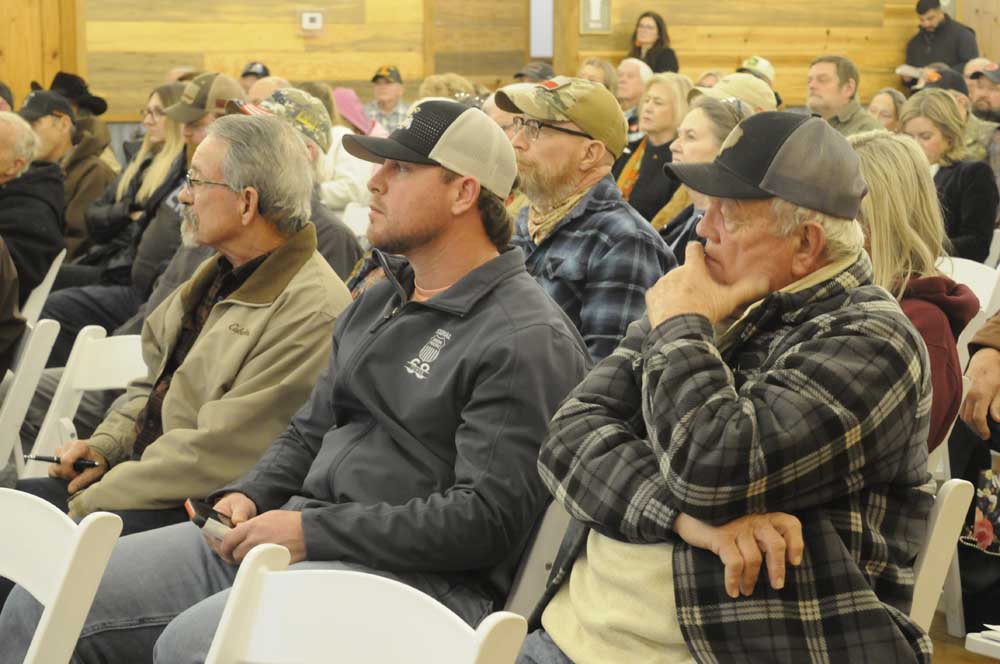Van Zandt County residents oppose battery storage project
Published 5:40 am Tuesday, March 4, 2025

- At a Feb. 20 meeting in Van Zandt County, some residents listened with frustration, shaking their heads and murmuring among themselves as concerns about the Amador Energy Storage project were discussed. (Katecey Harrell/ Tyler Morning Telegraph)
Many stay or return to their rural hometowns for peace, nature and solitude. In Van Zandt County, residents are fighting foreign companies they say threaten that way of life.
“One of the main reasons I moved out here is to get away from light and sound pollution,” said Matthew Hernandez, Director for Texas House District 2 Rep. Brent Money. “That’s a beautiful part of what we have here in Texas, but as you can see now, that’s being infringed upon by these companies.”
Amador Energy Storage, a 100 MW battery storage project in rural Van Zandt County, is being developed by Taaleri Energia, a Finland-based wind, solar and battery storage fund manager. Construction on the $90 million project began in December 2024, with operations expected by December 2025.
At a Feb. 20 meeting, over 100 residents gathered to learn about the project and voice safety concerns, including the risk of fire and environmental damage from a lithium battery explosion.
According to the Amador website, the developer believes the project will bring “significant” benefits to Van Zandt County, requiring “few” public services but contributing over $10 million in property tax revenue. The facility could prevent power outages like those caused by Winter Storm Uri, improving the reliability and resilience of the local power grid, the website states.
Despite the potential benefits, local residents continue to voice concerns they feel have not been addressed by the company.
“This has been a never-ending rabbit hole,” said Nancy White, a homeschool mom and energy project opponent. “Every time I have a question, more questions arise, and it just seems insane.”
Fire safety risks
Van Zandt County has only one full-time fire department in Canton, while other areas rely on volunteer fire departments lacking proper equipment and protective gear for hazardous material fires. Firefighters’ current gear is designed for thermal protection, not for exposure to hazardous chemicals, which increases cancer risk.
Lithium fires require hazmat gear, as exposure to toxic particles can be deadly. Fire departments responding to lithium battery fires don’t use water, but rather work to keep metal storage containers below 176 degrees Fahrenheit. Given that storage sites can contain up to 150,000 pounds of lithium, preventing overheating is crucial. However, the closest fire department is over 15 miles away, and specialized hazmat teams are over 95 minutes away, making emergency response slow.
Amador Energy Storage claims the project is designed with fire safety features, including training for local fire departments and mutual aid responders, with annual refresher courses at no cost. According to the website, battery fires do not require specialized equipment; firefighters monitor the fire, which is expected to self-extinguish with facility support.
National security concerns
White also raised concerns about China-based company CATL (Contemporary Amperex Technology Co. Limited), which produces battery control systems. U.S. Sen. Marco Rubio and other members of Congress have labeled CATL a national security threat due to its ties to the Chinese Communist Party (CCP). CATL control systems were removed from U.S. military bases for security reasons but they are still being installed at battery storage sites across the country, including Texas.
Gov. Greg Abbott’s executive order warns the CCP has threatened to use American infrastructure, including the energy grid, to cause harm. Lithium battery fires, if uncontrolled, could damage water supplies, livestock and farmland, similar to the Moss Landing fire’s impact on California’s agricultural sector.
Cybersecurity risks
Cybersecurity risks are another concern. A 2021 investigation into a lithium battery fire revealed that a malfunctioning fire suppression system triggered the thermal runaway, causing the fire. Experts warn that a cyberattack could change a single digit in a system’s code, overheating batteries and causing catastrophic failures. With over 900 planned lithium storage sites in Texas, this poses a significant risk to critical infrastructure, including water supplies and food production.
Lack of oversight
Regulatory agencies responsible for overseeing battery storage systems and power transmission are not properly monitoring cybersecurity threats. Engineers primarily focus on mechanical issues, rather than software vulnerabilities. White said previous investigations into unauthorized equipment from the same Chinese company, raising concerns about backdoor access.
From inadequate fire protection and evacuation plans to national security and cybersecurity risks, Van Zandt County residents argue for stricter regulations to address these concerns.
“In the middle of the country, where you’re supposed to hear birds and enjoy quiet, you’re hearing loud electrical sounds in your backyard,” White said. “What can we do? What are our options?”
National Fire Protection Association (NFPA) 855
When Taaleri first met with Van Zandt County commissioners, Precinct 2 Commissioner Cliff Williams said they initially believed the project would be well-received. However, as citizens began researching the safety of battery energy storage systems, they found troubling reports of fires and explosions.
The commissioners began to scrutinize the safety of battery storage systems, asking the developers for information such as testing results, emergency plans and commissioning details.
The initial testing results provided by the developers did not meet required safety standards.
The tests showed that the batteries experienced thermal runaway, where one battery ignites and potentially causes others to catch fire. The runaway was not contained, and the smoke and emissions were found to be flammable outside the container.
“If they’re safe, if they comply with all the rules established in Texas, they can turn it on,” Williams said. “But if they don’t comply with every detail of NFPA 855, they cannot.”
Amador Energy Storage asserts it is fully compliant with NFPA 855.
391 Commission
The county has unanimously voted to establish a 391 Commission, which will collaborate with other political subdivisions to create a Regional Planning Commission. The commission ensures that state agencies work together to protect citizens and support community development.
White explained that the commission allows the county to request vital information from state and federal agencies, strengthening their position. The Regional Planning Commission brings together counties, cities and special districts, providing more collective power than individual towns could have on their own.
Williams said he has spoken with Henderson County, noting it is also considering the 391 process. He said discussions are ongoing with other East Texas counties that may join the initiative.
Legislative efforts
State legislators are also working on solutions to address concerns about battery energy storage. Rep. Money outlined three initiatives under consideration in a video presentation at a community meeting.
One is Senate Bill 934, which would prohibit green energy projects from using software or components sourced from foreign adversary nations.
Another initiative focuses on updating fire codes to require facility operators to provide adequate training and firefighting equipment at their own expense.
The third initiative would give counties more regulatory authority over industrial projects in unincorporated areas, requiring developers to obtain permits from the County Commissioners Court after at least two public hearings.
Taaleri Energia representatives were not present at the town hall to advocate for their project.
“They know they’re not wanted here,” White said. “Even though they don’t intend to back out.”
White believes the technology behind the project isn’t ready and that the risks, particularly regarding fire mitigation, remain unaddressed. While the company outlines its commitment to safety, White said Texans have long held the mantra “Don’t mess with Texas,” and this project isn’t welcome in the state.






